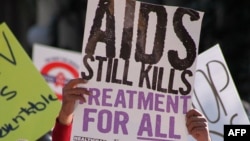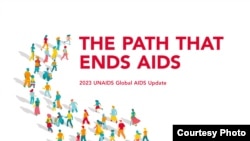Last week, UNAIDS issued a report titled "The Path that Ends AIDS," detailing studies to prove that the world can defeat the epidemic which begun four decades ago, by employing political leadership and financial investments.
Anne Githuku-Shongwe, the UNAIDS regional director for eastern and southern Africa, told VOA from Kigali that HIV is still "the leading cause of death, or at least (among) the first top three leading cause of deaths in many countries."
"Because we have done so well — having people living healthy lives for long periods of time — we have sort of dropped the ball and lifted our eyes off what we were doing," she said.
"We’ve turned attention to other things and assumed that the fact that we have treatment protocols, HIV is no longer the death threat, but yet the virus killed 630,000 people in 2022 alone."
Githuku-Shongwe said efforts by some African parliaments to enact laws that criminalize same-sex relationships in the face of stigma and discrimination risks eroding gains made.
"It means that communities who are at high risk and very vulnerable to HIV have to hide. They’re unable to go to centers where they can access those services, and so the chances of them being highly infected becomes a big problem," she noted.
"Communities are quite transient, they’re not only having sex within a particular group. Men who have sex with men having sex with other men, but they’re also married or have relations with other women or different key populations. So, it’s a vicious cycle that takes place if we don’t protect all the groups."
The report said although there’s a "steep drop" in new infections in young people aged between 15 and 24 years, the numbers aren’t declining for young men in sub-Saharan Africa.
In the region, these demographics account for about 66% of new infections for those aged 15 years and over 77% for people between 15 and 24 years.
According to the report, approximately 160,000 adolescent girls and young women in sub-Saharan Africa between 15 and 24 years contracted HIV — that’s more than half in 2010 at 53%, compared with 47,000 for boys and young men at 66%.
"Those trends point to a glaring blind spot in HIV responses," the report noted.
It also said beyond sub-Saharan Africa, there’s a "slower progress" in new HIV prevention. Eastern Europe and Central Asia is seeing steep rises in annual infections, like the Middle East and North Africa at 49% and 61% respectively since 2010.
Infections in Key Populations
However, the scenario is different for those in the Caribbean, Latin America and the Pacific as those regions experience a decrease in the number of new infections.
The UNAIDS’s Githuku-Shongwe said African countries like Botswana, Eswatini, Rwanda, Tanzania and Zimbabwe are succeeding in efforts to end the virus by 2030, because of their sustenance of political leadership and financial investments, urging other leaders to follow suit.
"There are new infections in new populations – adolescent girls and young women in Africa, for instance. 3,100 girls are infected every single week, and this is a big issue for us as new infections are increasing at dramatic rates."
Gayle Smith, the CEO of the ONE Campaign, an international nonprofit organization fighting extreme poverty and preventable diseases in Africa, told VOA that despite successes chalked particularly in Africa such as "incidence of infections being reduced by 57%," it’s imperative to upscale investments to meet the new target of ending HIV by 2030.
"Resources are robust but they have fallen a little bit," she said.
"The world’s fight against HIVA/AIDS…..while it started in denial, stigmatization — sure there’s still some — but it started from a place of negativity. It changed and made two decades of progress because of a lot of compassion."
"Compassion has been a powerful fuel in this fight."
Smith added that the world maybe on the right path to ending the epidemic but warned against complacency.
"We can’t just claim victory now and stop. A lot of people think that this is over — it’s not. We’ve proven we can do it and so we have to keep going. We need to focus on those who are most vulnerable," she said.
"For example, a huge number of adolescent girls and young women in Africa are extremely vulnerable, their infection rates are very very high … so focusing on them means that empowering them and making sure that people who have still not been reached and still don’t have the low incidence that we want are the focus of our attention."
VOA’s Linord Moudou Contributed to this story.









Forum